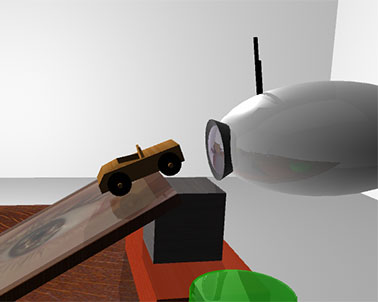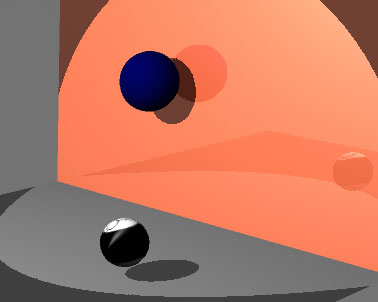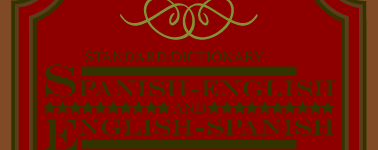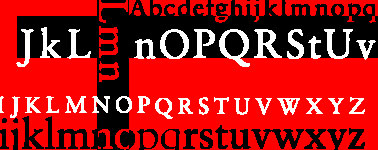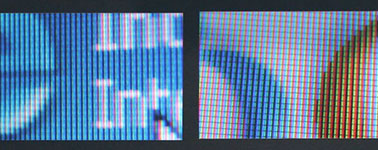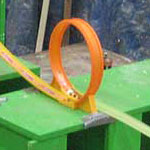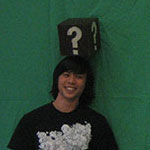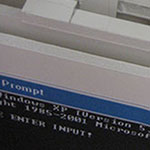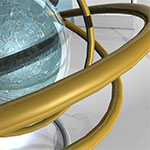Added Tuesday, February 21st, 2012 @ 8:20 PM
This was the second project for my intro to computer animation class sophomore year. I can’t remember exactly what the assignment was, but I’m sure it was something simple that I blew completely out of proportion and made it far more awesome than it needed to be.
Added Tuesday, February 21st, 2012 @ 6:53 PM
A pretty basic goal for our first intro to computer animation project—animate two balls of different consistency bouncing. Judging from the video, I’d say we had to do straight up and down bouncing as well as bouncing from a “thrown” angle.
Added Tuesday, February 21st, 2012 @ 6:44 PM
This assignment was to design the front and back cover for a Spanish-English/English-Spanish dictionary. All of the text was given to us by the teacher; all we had to do was make it look good!
Added Tuesday, February 21st, 2012 @ 6:41 PM
For this project, we were all given the name of a website. We were then supposed to design three different covers of books that the site would fictionally publish. On the covers, we needed to have both the name of the website along with its slogan. My website was OldCookbooks.com, and its slogan at the time was “Sets and collections, advertising pamphlets and cherished family favorites that have inspired moms and other great cooks for generations.”
Added Tuesday, February 21st, 2012 @ 6:40 PM
For this project, we were each assigned a font and an artist. My font was Sabon, and my artist was Lazar Markovich Lissitzky, better known as El Lissitzky. We were to make a poster displaying our font’s name and letters (using the font) in the style of the works of our artist. If you take a quick glance at El Lissitzky’s works, you’ll see the resemblance.
Added Tuesday, February 21st, 2012 @ 6:38 PM
The title pretty much says it all. The objective of this project was to find type our the environment. We were to pick a single environment, photograph the different type in it, and display the photos in a grid on black foam board. I decided to focus on type in my dorm room, and from there I limited it to type on my computer screen.
It’s all here in my original description 😛 :
When this project was assigned and described as “type in your environment,” my first thought was type in my dorm room. From there I limited it down to type on a computer monitor and from there different type in Windows –its interface and its most commonly used programs. I took pictures of things like the Start Menu, Windows Explorer, Internet Explorer, and iTunes. Initially it seemed to me that there really was not that much differentiation in type, but as I went along and really looked at the pictures that I was taking, I realized that some type that looks identical normally has even the slightest variation on most occasions; thus, I realized how many different types there are just in the Windows interface itself in addition to its programs (which in most cases are designed to have the same theme, and thusly fonts and type, as the interface). Aside from the type aspect of the project, I also learned some new techniques for using my camera’s different macro settings, which I know will be useful in the future.
Added 2/21/12 @ 6:35 PM
This assignment was to make our “best (sculpture) project ever.” It was the final project for my sculpture class. We were allowed to redo/improve a project we had made earlier in the semester or create something totally new. We were also allowed to partner up if we wanted. I partnered with another student in the class, Chris. We decided to take one of his previous projects and make it a billion-kajillion times better! His previous project was a short Rube Goldberg. How do you make a Rube Goldberg better? Make it longer, more convoluted, and more ridiculous! All of the steps in this Rube Goldberg were designed to accomplish one thing—celebrate the end of the semester by dispensing candy and confetti.
Here is the original description of the piece:
“Grand Finale” is a collaborative project based upon the works done mainly by Rube Goldberg. The definition of a “Rube Goldberg” in the dictionary is “a comically involved, complicated invention, laboriously contrived to perform a simple operation.” “Grand Finale” fits this definition perfectly.
As with any Rube Goldberg, many themes and ideas can be seen in this piece. One such as laziness or inactivity can easily be read –“Who would go through the trouble of creating a device to do such a menial task when, in the time spent building said device, the creator could have, most likely, done the sought after task hundreds of times?” One could argue a theme of genius innovation and technical brilliance –“This is such an amazing machine! How did the creator ever think of this?!” One could even go so far as to declare a comment on the state of human kind –“People rely far too much on machines. Without machines, people wouldn’t be able to do anything!” These are all valid interpretations which connote their own individual views and beliefs upon the piece. Please feel free to decide for yourself what you believe this piece is about.
As one can clearly see by simply looking at the piece, it is a very large and complicated work. The piece is strung together by a series of events which are triggered by preceding events and, in turn, trigger following events.
The first event is that the user pulls a string which causes a door to open inside a large-walled tunnel. The upward removal of this door triggers the first step in this long and marvelous machine. The ball. The ball is the start of it all. As the door is lifted, it allows a croquet ball to gently roll along a slanted tunnel and into a series of three downward-angled ramps; it noisily clanks and clashes to its next destination. The ball then cascades down a long, vertical shaft, and lands at the bottom, thus rolling out of a small hole and onto wooden, bordered paths. When the ball reaches the end of the paths, it furiously hits a set of weights off of its resting place on the edge of the shared path. The falling motion of the weights pulls on a string attached to said weights. This string loops around a wheel device and is put through a wood block via a drilled hole. The weights, in combination with the string and wheel, act as a pulley device which lifts the front of the aforementioned wood block, which, in turn, causes the opposite side of the block to dip down. Another set of weights, resting on the wood block, then slides down the block and allows gravity to do its duty; it falls down which, thanks to another pulley device similar to the first, lifts yet another door. This door, now removed, releases a toy car which, with its barrier eliminated, begins to roll down from its resting place. The car then reels onto a set of precariously, deviously, and quite cleverly placed Hot Wheels tracks. After a stunning display of loops and turns, the car is launched into the air, across a multiple foot gap from one table to another. Depending on the wind of the course, the mood of the gods, and the lunar tides, the car will either make it to the next table and slide to a victorious stop, or the car will ram into the side of the table and fall into a sea of failure. Regardless of our brave heroes end, its job will be done, for you see, this direct contact or indirect vibration will set into motion a path of dominos. The dominos will slip and slope, slump and spill, and of course, tip and tumble their small but dedicated ways across the table in a fascinating array of both glee and tragedy. After the fallen dominos have taken their stand (or lack thereof), they will pitch in one last desperate measure and throw their strongest off of the table. Yes, that’s right, a stack of three dominos. The taped stack of domino warriors will then fall headlong to the ground, rapidly approaching their tragic end. Lucky for our dominos the creators of this piece did not want them to die. In vein. The dominos, while falling, drag down with them an attached string. This string is tied not only to the dominos, but also a high-hanging, smaller string, feet above. This string is quite different from the others used in this glorious display of ingenuity. For this string, you see, acts as a zip line of sorts. A device (which we will thusly name Ricardo, or Bob, or Jacques… or really whatever name feels right for you and your personal pleasures) which has tiny wheels on its inside rides down the path the string lays out for it; merely a child’s plaything, used for something of much, much greater and graver importance. So as the dominos say their final farewells, they pull with them a string which is tied around Ricardo’s life line, if you will. When the tension from the dominos pulls on the butterfly loop tied to Jacques’ string, the loop releases, and allows Alexander to freely fly down his rope of truth and justice. As Stephen glides along his tethered avenue, he gazes upon his companions who have either willingly or unwillingly (we don’t really know) given their lives, their passion, their complete devotion to the cause of a greater good. What brave, brave souls. The task for which they have all strived will soon be complete. As Bob finishes his deed, he rolls to an abrupt stop as he runs into a ladder (onto which the other end of his string has been tied). The exact spot he hits, however, is more than just the side of a ladder (for that would be both anticlimactic and cruel to brave Bob), it is actually a very happy and cheerful light duct taped to the side of the ladder. Our jubilant light comes complete with a warm, loving glow and a smile big enough to span the colossal chasms of the Grand Canyon itself. So with Stephen turning on our cheery light, the observing crowd could not be more satisfied with this classic Rube Goldberg. Unless, of course, there were a balloon filled with confetti tied to Ricardo which would hit a needle taped to the ladder, as Alexander himself hit the ladder, thus causing the balloon to instantaneously pop with a loud bang and release its wondrous treasures (confetti for those who weren’t paying attention) all among the viewers and among various other surrounding objects and/or persons. It couldn’t get any better than this! But what if, just what if, there were a bowl of delicious candy which was also knocked over and scattered onto the floor and table? That would be terrific! Well it’s a good thing there is such an object (we wouldn’t want to disappoint)! And with the fall of the treats, the job is complete. What began with a simple pull of a string started a series of events strung together by levers, pulleys, gravity, knots, and yes, string. In the end, the user bypasses the need to turn on a light and distribute candy him/herself by use of this overly complicated, thoughtfully playful, and very dramatic Rube Goldberg device. And thus ends Chris’ and Adam’s best Sculpture 2701 project ever.
Added 2/21/12 @ 6:33 PM
Like the previous two projects, “lines in space” and “planes in space,” students were tasked with making a sculpture that used “cubes in space.” I decided to take a similar route to my “lines in space” project. I first made a wooden cube and painted it to look like a ? block from Super Mario. I then created a C# program that used a Wii remote as a motion detector (I had been dying to try my hand at creating my own program that used the Wii remote), and put with Wii remote inside of the wooden box. Lastly, I set up a green screen and my camera to create a live virtual Mario environment. Whenever someone would stand in front of the green screen, they would appear at the beginning of World 1-1 from Super Mario Bros. on the projection next to the green screen.
Originally, I had wanted to animate the projection so that when users bumped the physical box, a coin would pop out on the projection’s box. However, the program I was using to do the live green screening didn’t allow something like that. Instead, I had a window open on my computer monitor (which was in front of the green screen, facing the user so that they could see it while in front of the screen) that housed this animation. Whenever someone would hit the physical box, the Wiimote would detect this, send a signal to the computer, and the Mario scene onscreen would animate by having a coin pop out of the (onscreen) box. Also the Mario coin sound would play!
Added 2/21/12 @ 6:30 PM
Similar to the previous “lines in space” project, for this project, we were supposed to make a sculpture that utilized “planes in space.” I decided to make an “analog computer,” if you will. I created a CPU tower with two holes in it, one at the top and one at the bottom. Also on the front of the tower, there is a command prompt window asking the user to “enter input.” This is done by sliding the tabs in the tower’s top hole to one side. By doing so, a panel slides down the tower and becomes visible as a “program window” through the tower’s bottom hole. The user can then “change programs” by sliding the tab on the left side of the tower back up, locking it in place with the tab that had been slid to the side, and sliding a different tab to the side (dropping another panel).
Added 2/21/12 @ 6:27 PM
The goal of this project was to create a sculpture that used “lines in space.” I chose to create lines that were both in a virtual space as well as a physical space. I modeled a virtual room in 3ds Max (this was the first time I used the program and was before I had used Maya) along with a couple of shelves with some items on them and a box between the shelves. I also created the shelves and box in real life using pieces of wood. I set up the box and shelves in the corner of the crit room and projected the virtual room onto the corner and the physical shelves/box. Viewing from the right angle, a false sense of depth was created. It looked as though the virtual room went back into space as if the walls it was projected onto were not there. So I had, with virtual and physical lines, created a space that didn’t actually exist. A pretty cool effect if I do say so myself!
Added 2/21/12 @ 6:24 PM
This was the third project in my intro to computer modeling class sophomore year. The title is self-explanatory—we had to model a table with (probably a certain number of) items on it. This project contains what is perhaps the most detailed model I have made to date (aside from building complexes). The Wii model on that beautifully designed table is detailed enough for Nintendo themselves to use as a template for the factory. It even glows like the real thing!
All models except for Link, his shield, and his bomb were created from scratch by me. Though I did rig and pose Link!





